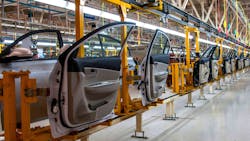6 Steps to Long-Term Resilience for Automotive Supply Chains
Download this article in PDF format.
Automotive supply chains have dealt with more than their fair share of disruption over the last few years. The global pandemic, chip shortage, labor constraints and transition to electric vehicles (EVs) are just some of the better-known issues that have impacted these vital networks in recent years. The outcomes have ranged from production delays to factory shutdowns to higher prices, all of which have a direct impact on consumers.
As the automotive sector works to address these and other disruptions, many companies are diversifying their supply chains in an attempt to “cover the spread” and ensure ample supply availability across different product categories. Automakers are also improving their efficiency levels and investing in new technologies that can help them work better, smarter and faster amid the ongoing uncertainty.
“Organizations have found themselves in an environment that requires more agility and responsiveness from supply chain management in the automotive industry,” Capgemini Research Institute points out in Automotive Supply Chain: Pursuing long-term resilience.
“While most have adjusted in this direction to remain competitive, the industry has overall struggled to cope with recent events, from the pandemic to geopolitical shocks,” the organization continues. “Several systemic challenges to efficient supply chains remain, and new ones have also emerged. These include an over-reliance on boosting inventory to manage uncertainty, faltering sustainability efforts as companies’ attention is diverted to other problems, and issues between OEMs and suppliers.”
6 Steps to Better Supply Chain Resilience
Here are six ways Capgemini says automakers can begin building more resilient supply chains that can also deliver a competitive edge:
- Optimize inventory by using technology to build an intelligent, data-driven supply chain. Modern technologies like predictive analytics and machine learning (ML) can monitor and deliver insights into risks. For example, Mercedes-Benz and Microsoft have partnered to create a data platform called MO360, which is expected to improve production efficiency across the OEM’s 30 worldwide manufacturing plants by a projected 20% between 2022 and 2025.
- Foster transparency and good supplier collaboration. Building trust is the key here. Once that trust has become established, companies can build long-term capacity and resilience. Effective collaboration and strong ecosystems enable transparency and visibility, Capgemini points out, thus facilitating better forecasting and risk management. “Automotive organizations should establish supplier relations policies laying out common working rules and ethical guidelines,” it adds. Those policies should include key elements like isolation of operational and risk information from vendor-selection processes; transparency and disclosure; conflict resolution and arbitration; and timely communication.
- Place a special emphasis on the battery value chain. Nearly three in five respondents to Capgemini’s survey say their companies are investing directly in mining operations to secure raw materials for battery manufacturing. The company suggests using a “collaborative approach” to produce better outcomes. “Automotive organizations should build a wide range of partnerships to develop battery resources through joint investments and long-term secured contracts,” it adds. “Investment can be optimized by balancing different materials, sources, and regions.”
- Implement a workforce management plan focused on automation and the transition to EVs. To ensure that the automotive workforce can migrate effectively on both fronts, companies should assess how technology transformation will affect the workforce; define new roles and set up an upskilling process; and train leaders on the fine points of effectively communicating change.
- Develop a data-driven and agile supply chain culture. Changing organizational culture requires considerable time and effort. “Most supply chain functions are experience-based but this system can break down in the face of unprecedented challenges or volatility,” Capgemini points out. Companies can begin building a data-driven culture by appointing and empowering “change agents” to drive that culture; empowering workers at all levels with the right tools and skills; and using integrated business planning (IBP) tools to increase transparency.
- Use sustainability and circularity to build resilience and consumer loyalty. “By integrating sustainability and circularity into their supply chain strategies, businesses can create more resilient and future-proof operations, with fewer concerns about resource availability,” Capgemini states. This is already happening in the automotive sector. For example, Renault is replacing its traditional auto manufacturing plant in Flins, France with recycling and reconditioning activities, and BMW Group Plant Dingolfing will use heat produced from regional biomass (and its own waste wood) to fulfill about 50% of its processes’ hot water requirements.
About the Author
Avery Larkin
Contributing Editor
Avery Larkin is a freelance writer that covers trends in logistics, transportation and supply chain strategy. With a keen eye on emerging technologies and operational efficiencies, Larkin delivers practical insights for supply chain professionals navigating today’s evolving landscape.






